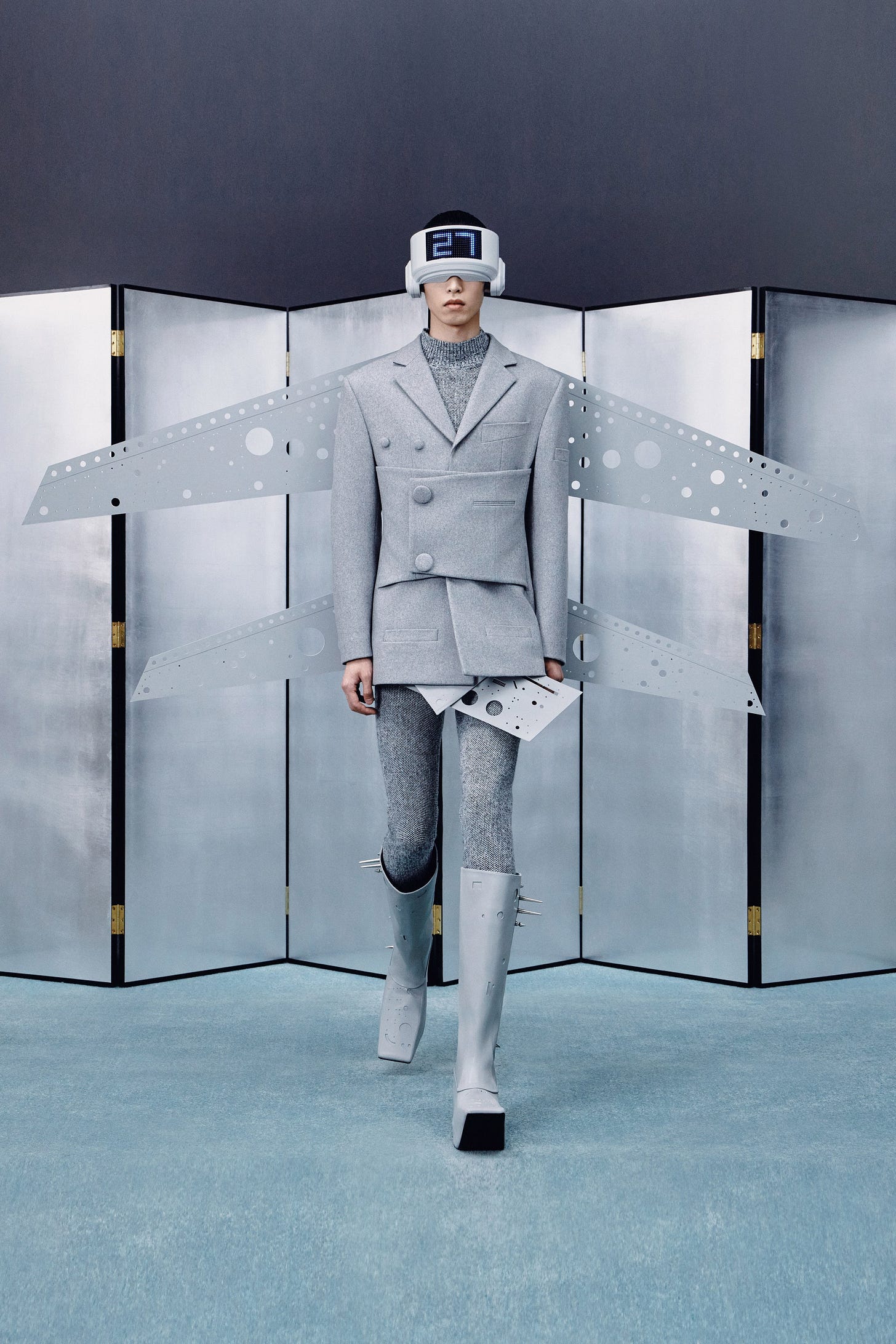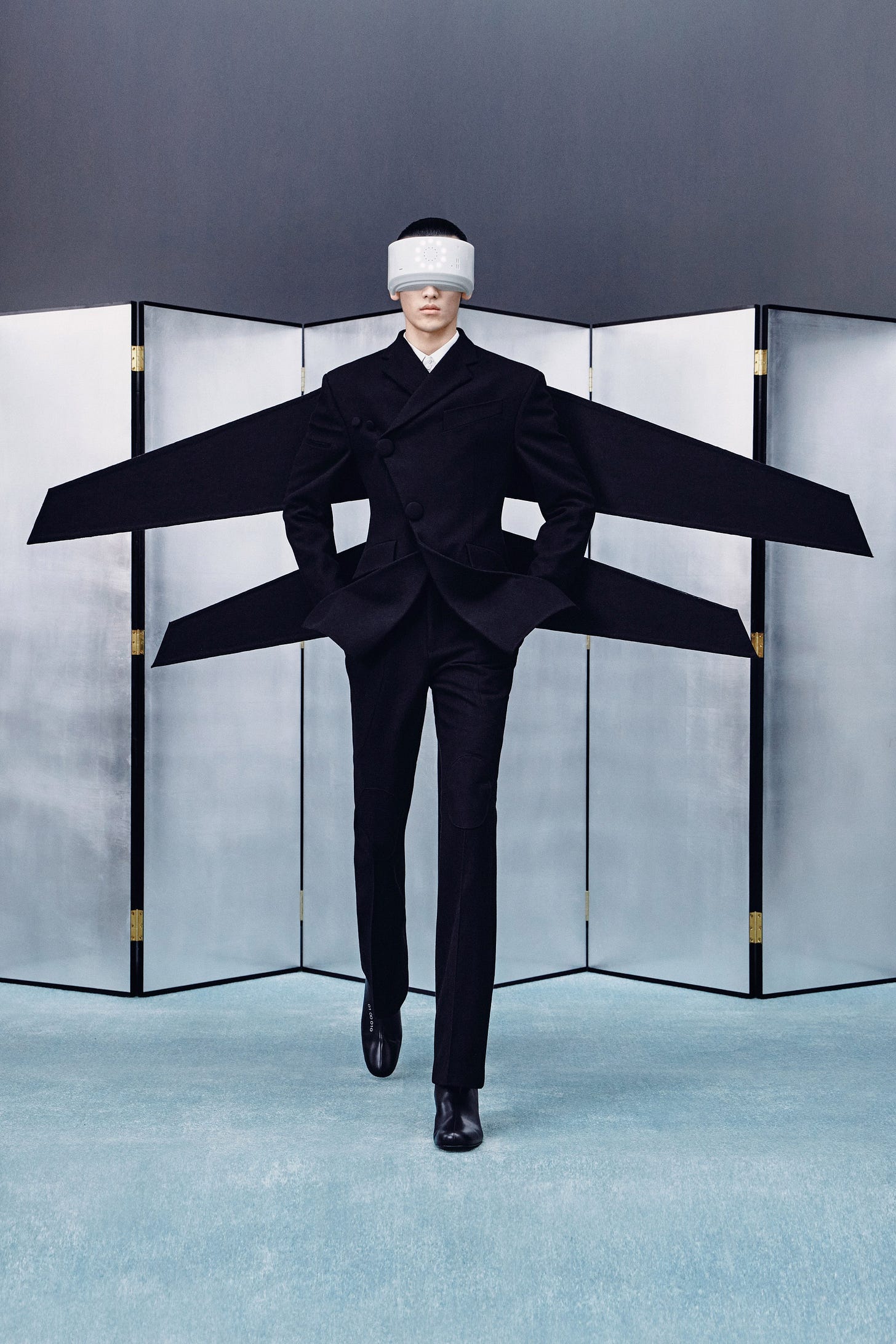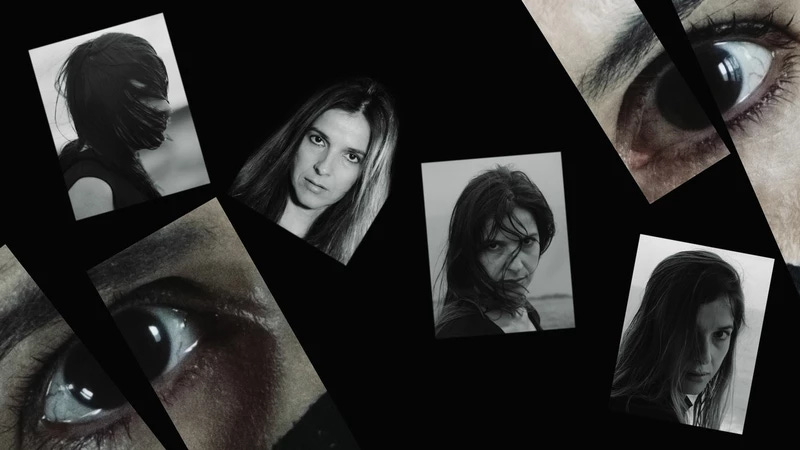I was planning on a late review of Jun Takahashi’s 25th anniversary show but was so bowled over by this show I wrote about it instead:
XANDER ZHOU FW25
No one should be showing more than 70 looks at a fashion show.
Experiencing a very long movie, play or book is an experiment in changing the viewer’s relation to time. However, in these mediums, their environmental impact is not so much greater because of their size as to shift politics. Consider AI “art,” or really, anything. AI-assisted work is despicable not because of the product itself but because of the comparative energy expended to make it. Something like a Satantango or Proust gives time back to the audience generously, offering a pause from constant capitalist motion. AI “content” literally brings us closer to water wars. A gargantuan fashion show is somewhere in between - where the environmental impact of largesse supersedes artistic merit.
This is kindly implying gargantuan fashion productions are more about artistic indulgence than plain old corporate glut. Filling 80 or 90 looks with clothing/shoes/accessories for a global brand of stratified price points and clients is a commercial reality. As much as this scale benefits immersive and subversive worldbuilding, it is mostly in the service of weaseling in larger lines, more product, more to post.
Xander Zhou is the only designer who seems to negate these criticisms of fashion largesse. Zhou is a Chinese based designer who has been active since the mid-2010s, operating within the buzzword spaces of streetwear, now menswear. He is a sci-fi maven, a comedian couture futurist. His is an inspired, profoundly committed silliness, a costumed sci-fi that feels strangely grounded. Zhou loves masks, canes, and thick coats, and suits that would be favored by Star Wars military bureaucrats. He loves to disappear bodies behind the maddened structure of warped uniformity.
FW25 gives language to Zhou’s practice of the constant modification of fixed uniform, costume, or type: “Variation within frame.” His archetypes are prim suits with sashes, high boots, and rigid matte gliders. Bodysuits are silvery greys and whites, the blues and turquoises slink like poisonous toads, but my favorites are the blush pinks and putrid pale yellows. It’s all so damned business casual, so restrained while the forms of the suits switch and the details blur. We see every color and styling combination of sash, wing, and suit until things blur further. Pockets go where they shouldn’t or they double, suit becomes hoodie, screens and holograms appear on blazers, double breasted becomes wrap coat, all crescendoing in rotund, peaked collars and mouton coats. It is a 93 look show.
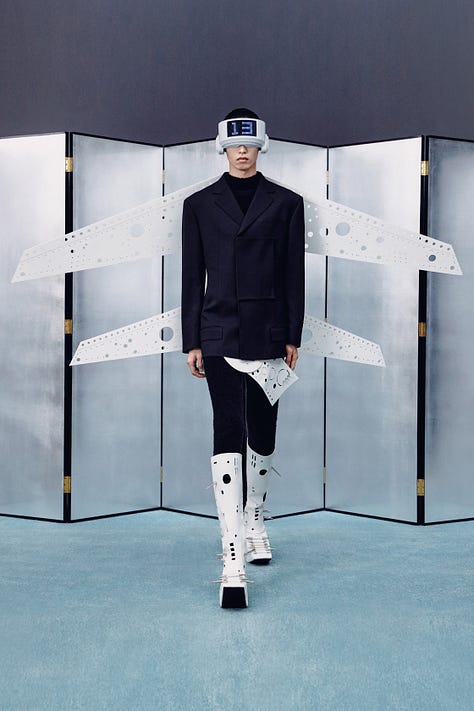
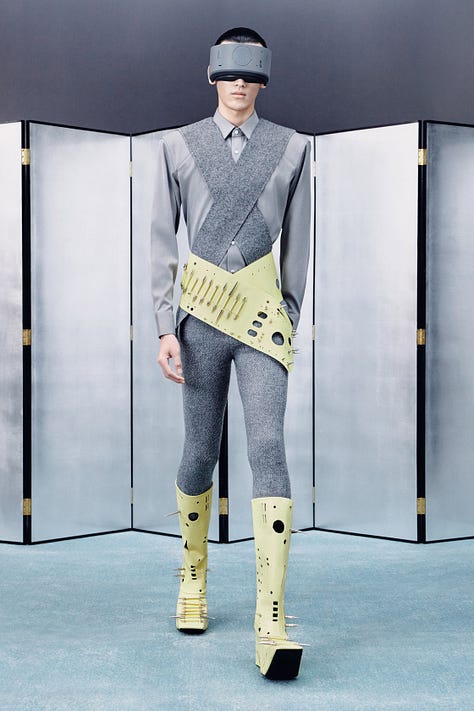
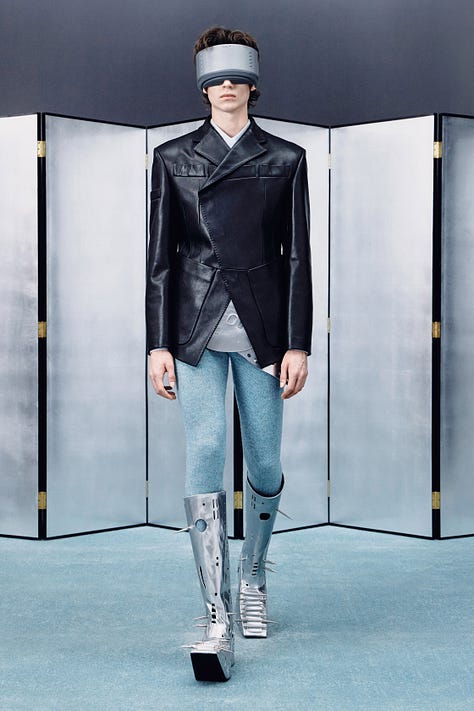
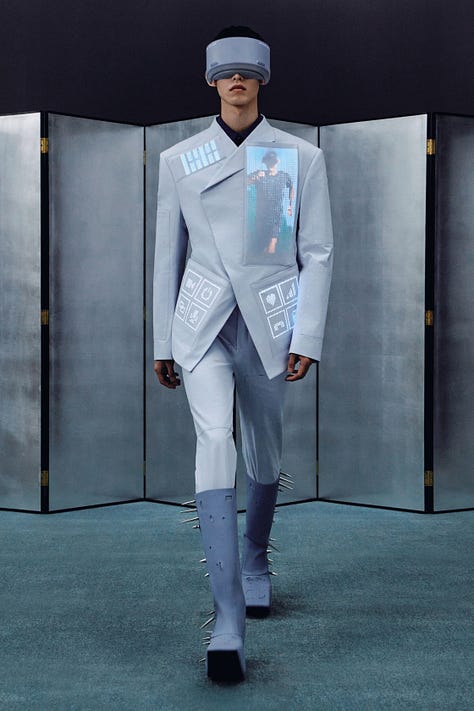
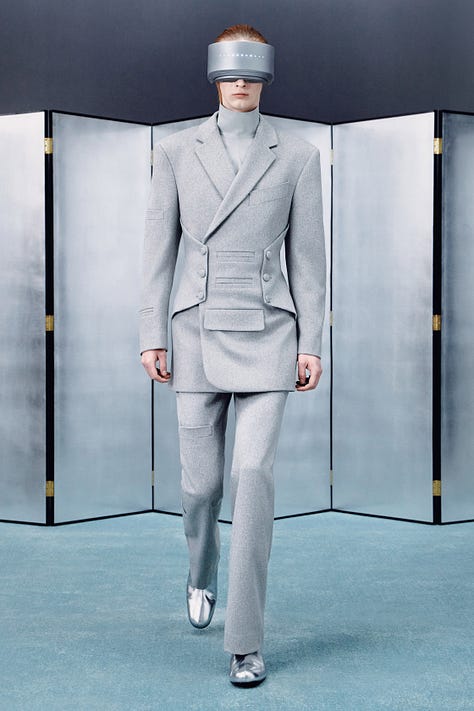
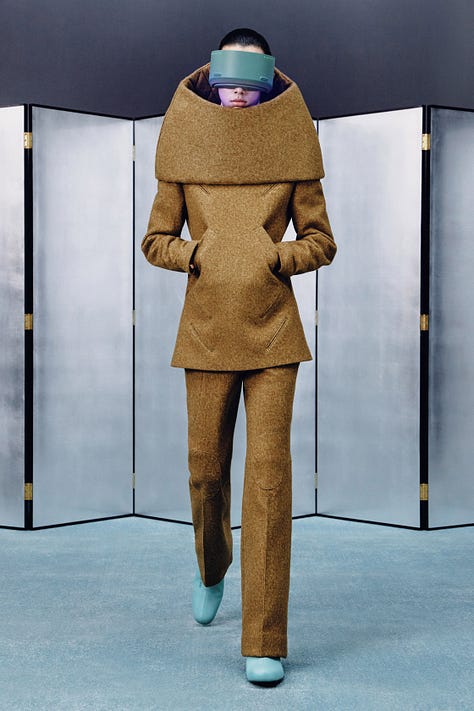
Zhou doesn’t see the show as about deconstruction, but rather how to “strip away reassigned functions of these elements and give them a new, even yet-to-be-invented purpose or form.” For example, when Zhou incorporates LED screens onto blazers, he writes on Instagram that “clothing is no longer decoration, but a transmitter of data—a wearable statement of one's current frequency within the universe.” Beyond the garment, Zhou is concerned with the way technology changes the way we experience reality, comparing ancient systems of prophecy like the I Ching to “a language for perceiving and encoding reality.”
Zhou’s skill is in making these ideas palpable both through the expanse of 90 looks or the minutiae of a perfectly warped blazer in periwinkle. These are costumes that feel lived in, if not livable. Zhou’s clothes offer the possibility of existing within a futuristic mystique. Zhou is the rare fashion designer whose curiosity about technology yields dazzlingly earnest oddity and insight rather than trendy - think Comme Des Garcons’ FW12 2D show rather than Gucci NFTS.
And yet Zhou also has a soft spot for energy gobbling techno-tricks masquerading as futurism. Zhou had AI designing graphics and writing press releases as early as 2020. In FW23 Zhou directly employed an AI scene for a digital lookbook and said he took on the perspective of AI learning to craft the collection. He says, “I hope that AI can become a good tool, an assistant, or even a promising partner for creators like me. For next season, I will let AI try to use my design ideas and learn from collections I designed in the past, and see if the program can design a new XANDER ZHOU collection for me.”
Blissfully, it did not. SS24 was entitled “Pro A.I Volution” (subtle, I know) and showed characters imagined to have “evolved evolved by way of absorbing AI (Artificial Intelligence) and IA (Intelligence Amplification).” Models had extra arms, some tails, others simply masked in transparent plastic. While in SS24 Zhou used A.I solely for research, he speaks optimistically about AI allowing humans to “become smarter and keep our humanity.” Recently, Zhou included an AI studio in his FW25 credits as well as featuring an AI exchange in an Instagram caption advertising the collection.
The frustrating thing about Zhou’s AI bullshit is how much his work is imbued with humanity. It’s Zhou’s very human taste, philosophy, and style that make his depiction of technology, optimization, and the synthetic so meaningful. His strength is not just in fantasy but so effectively grounding that fantasy in utility. The oddities and calculated wrongness of his work are not actually culled from the algorithm. These are very human glitches of a smoothly digital aesthetic They remind us of the potential for humanity hiding within a technologized world that amputates us from our personhood. They offer a bizarre hope for the future, a hope for unknown utility and purpose from the mundanely repressive.
Zhou overstated that AI is not creatively involved in his work - it is an insufficient collaborator - so what does it do? AI usage becomes an internal signal for futurism, a way of dazzling a potential client with how forward-thinking and computerized Zhou’s sci-fi really is. It is a wasteful, unethical tool that only dulls otherwise interesting work.
Consider the comparative wastefulness of Zhou’s 93 looks. Not every garment will be sold, many pieces are repeated throughout the show, and the whole experience is digital. Here, Zhou is taking advantage of the digital format as inherently cheaper - and thus with the potential to show a more fully realized digital world that can more easily move between formnats. Rhetorically, the span of 93 looks provides the space for ample repetition and a holistic exploration of every nature of glitch. With so many looks, Zhou’s shows transcend to become fully fleshed encoded realities, not mere slivers.
What would otherwise be seen as waste is repurposed as rhetoric. AI cannot be recontextualized in this way because its use inherently creates such an insidious environmental footprint.
Xander Zhou’s work is curiously oxymoronic, simultaneously making fascinating work that engages excess unlike most contemporaries while engaging in an excess that appears in his work with such slightness.
Art is always changing, but I don’t think it’s presumptuous or ahistorical to claim this century (if not the next twenty years) will annihilate the way we produce most forms of mass art. As our environment and collective societies shift, art will exist precariously close to waste. We are in the final years in which art production can be so callous.
CHRONICLES OF THE ABSURD
Secondly, I was given the great opportunity by Impulse Magazine to write about this fascinating film by Cuban director Miguel Coluya.
The film is an interesting foil to the idea of “necessary“ or functional art, and what art that goes against the grain of society looks and feels like.
The link is here :)



